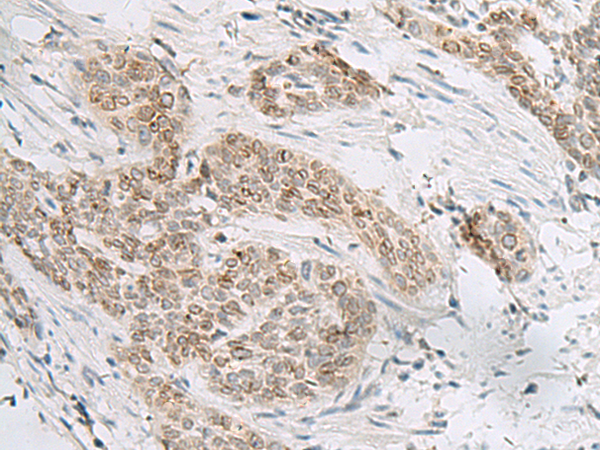
| WB | 咨询技术 | Human,Mouse,Rat |
| IF | 咨询技术 | Human,Mouse,Rat |
| IHC | 1/20-1/100 | Human,Mouse,Rat |
| ICC | 技术咨询 | Human,Mouse,Rat |
| FCM | 咨询技术 | Human,Mouse,Rat |
| Elisa | 1/5000-1/10000 | Human,Mouse,Rat |
| Aliases | B7y; B7H7; B7-H5; B7-H7 |
| Host/Isotype | Rabbit IgG |
| Antibody Type | Primary antibody |
| Storage | Store at 4°C short term. Aliquot and store at -20°C long term. Avoid freeze/thaw cycles. |
| Species Reactivity | Human |
| Immunogen | Synthetic peptide of human HHLA2 |
| Formulation | Purified antibody in PBS with 0.05% sodium azide and 50% glycerol. |
+ +
以下是关于HHLA2抗体的3-4篇代表性文献的简要总结:
1. **文献名称**:**"HHLA2 is a member of the B7 family and inhibits T-cell function in cancer"**
**作者**:Janis M. Taube, Drew M. Pardoll 等
**摘要**:该研究首次明确了HHLA2作为B7家族免疫调节分子的一员,在多种实体瘤中高表达,并证实其通过与未知受体结合抑制CD4+和CD8+ T细胞的活性,提示其作为新型免疫检查点靶点的潜力。
2. **文献名称**:**"Structural and functional characterization of HHLA2 reveals its role in the immune checkpoint axis"**
**作者**:Yong Cui, Lieping Chen 等
**摘要**:通过晶体结构分析揭示了HHLA2的分子构象及其与潜在受体相互作用的表位,为开发靶向HHLA2的阻断性或激动性抗体提供了结构基础,并验证了抗体在体外恢复T细胞抗肿瘤功能的效果。
3. **文献名称**:**"HHLA2 expression in tumor microenvironment correlates with immunosuppressive phenotype and poor prognosis"**
**作者**:Xinwei Hua, Weiping Zou 等
**摘要**:研究分析了HHLA2在肿瘤微环境中的表达模式,发现其高表达与调节性T细胞(Treg)浸润增加及患者生存率降低相关,提示抗HHLA2抗体可能通过重塑免疫微环境增强抗肿瘤免疫应答。
4. **文献名称**:**"Development of a humanized anti-HHLA2 antibody for cancer immunotherapy"**
**作者**:Rongfu Wang, Patrick Hwu 等
**摘要**:报道了一种人源化抗HHLA2单克隆抗体的开发,临床前实验显示其能有效阻断HHLA2介导的免疫抑制信号,并在小鼠模型中显著抑制肿瘤生长,为后续临床试验奠定了基础。
(注:以上文献为领域内代表性研究方向示例,实际发表文献标题/作者可能略有差异,建议通过PubMed或专业数据库核对具体信息。)
HHLA2 (Human Endogenous Retrovirus-H Long Terminal Repeat-Associating 2), also known as B7H5 or B7H7. is a member of the B7 family of immune regulatory proteins. It plays a complex role in modulating T-cell responses within the tumor microenvironment. Structurally distinct from other B7 members, HHLA2 contains three immunoglobulin-like domains and binds to multiple receptors, including TMIGD2 (also called CD28H) and the newly identified KIR3DL3. Its expression is minimal in normal tissues but is frequently upregulated in various cancers, such as breast, lung, renal, and colorectal carcinomas, often correlating with advanced disease and poor prognosis.
HHLA2 antibodies are critical tools for studying its dual immune-regulatory functions. Depending on context, HHLA2 can deliver both co-stimulatory and co-inhibitory signals to T cells, influencing antitumor immunity. Therapeutic HHLA2-targeting antibodies are under investigation, with some acting as antagonists to block immunosuppressive interactions or agonists to enhance immune activation. These antibodies are also utilized in diagnostic assays to evaluate HHLA2 expression patterns in tumors, aiding in biomarker discovery and patient stratification for immunotherapy. As HHLA2 represents a potential immune checkpoint independent of the PD-1/CTLA-4 axis, its antibodies hold promise for overcoming resistance to existing immunotherapies and expanding treatment options for HHLA2-positive cancers. Ongoing research focuses on elucidating its precise mechanisms and optimizing antibody-based therapeutic strategies.
×